Key Characteristics of Computer Memory Systems and Performance of Memory:
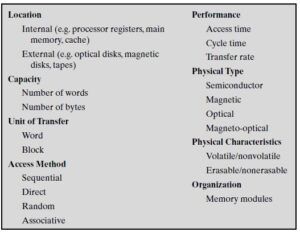
Based on three performance parameters performance of Memory:
- Access time (latency): For random-access memory, this is the time it takes to perform a read or write operation
- For non-random-access memory, access time is the time it takes to position the read–write mechanism at the desired location
- Memory cycle time: This concept is primarily applied to random-access memory and consists of the access time plus any additional time required before a second access can commence
- This additional time may be required for transients to die out on signal lines or to regenerate data if they are read destructively
- Transfer rate: This is the rate at which data can be transferred into or out of a memory unit
- For random-access memory, it is equal to 1/(cycle time)
- For non-random-access memory, the following relationship holds:
Where,
TN = Average time to read or write N bits TA = Average access time n = Number of bits
R = Transfer rate, in bits per second (bps)
Cache Memory Principles
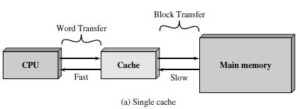
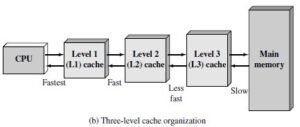
- The cache contains a copy of portions of main memory
- When the processor attempts to read a word of memory, a check is made to determine if the word is in the cache. If so, the word is delivered to the processor
- If not, a block of main memory, consisting of some fixed number of words, is read into the cache and then the word is delivered to the processor
- When a block of data is fetched into the cache to satisfy a single memory reference, it is likely that there will be future references to that same memory location or to other words in the block
– Locality of reference
Cache Read Operation
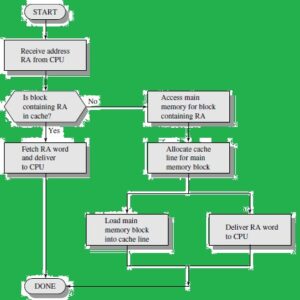
Elements Of Cache Design

Mapping Function
Because there are fewer cache lines than main memory blocks, an algorithm is needed for mapping main memory blocks into cache lines. Further, a means is needed for determining which main memory block currently occupies a cache line. The choice of the mapping function dictates how the cache is organized. Three techniques can be used: direct, associative, and set associative.
Cache Memory is a special very high-speed memory. It is used to speed up and synchronizing with high-speed CPU. Cache memory is costlier than main memory or disk memory but economical than CPU registers. Cache memory is an extremely fast memory type that acts as a buffer between RAM and the CPU. It holds frequently requested data and instructions so that they are immediately available to the CPU when needed.
Cache memory is used to reduce the average time to access data from the Main memory. The cache is a smaller and faster memory which stores copies of the data from frequently used main memory locations. There are various different independent caches in a CPU, which store instructions and data.
Levels of memory:
- Level 1 or Register –
It is a type of memory in which data is stored and accepted that are immediately stored in CPU. Most commonly used register is accumulator, Program counter, address register etc. - Level 2 or Cache memory –
It is the fastest memory which has faster access time where data is temporarily stored for faster access. - Level 3 or Main Memory –
It is memory on which computer works currently. It is small in size and once power is off data no longer stays in this memory. - Level 4 or Secondary Memory –
It is external memory which is not as fast as main memory but data stays permanently in this memory.
Cache Performance:
When the processor needs to read or write a location in main memory, it first checks for a corresponding entry in the cache.

- If the processor finds that the memory location is in the cache, a cache hithas occurred and data is read from cache
- If the processor does notfind the memory location in the cache, a cache miss has occurred. For a cache miss, the cache allocates a new entry and copies in data from main memory, then the request is fulfilled from the contents of the cache.
The performance of cache memory is frequently measured in terms of a quantity called Hit ratio.
Hit ratio = hit / (hit + miss) = no. of hits/total accesses
We can improve Cache performance using higher cache block size, higher associativity, reduce miss rate, reduce miss penalty, and reduce the time to hit in the cache.
Cache Mapping:
There are three different types of mapping used for the purpose of cache memory which are as follows: Direct mapping, Associative mapping, and Set-Associative mapping. These are explained below.

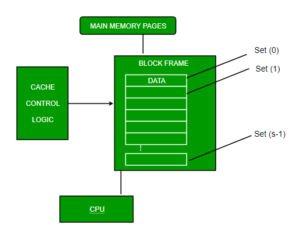
- Direct Mapping –
The simplest technique, known as direct mapping, maps each block of main memory into only one possible cache line. or
In Direct mapping, assign each memory block to a specific line in the cache. If a line is previously taken up by a memory block when a new block needs to be loaded, the old block is trashed. An address space is split into two parts index field and a tag field. The cache is used to store the tag field whereas the rest is stored in the main memory. Direct mapping`s performance is directly proportional to the Hit ratio. - i = j modulo m
- where
- i=cache line number
- j= main memory block number
m=number of lines in the cache
For purposes of cache access, each main memory address can be viewed as consisting of three fields. The least significant w bits identify a unique word or byte within a block of main memory. In most contemporary machines, the address is at the byte level. The remaining s bits specify one of the 2s blocks of main memory. The cache logic interprets these s bits as a tag of s-r bits (most significant portion) and a line field of r bits. This latter field identifies one of the m=2r lines of the cache.
DIRECT MAPPING is the simplest technique, known as direct mapping, maps each block of main memory into only one possible cache line. The mapping is expressed as
𝒊 = 𝒋 𝒎𝒐𝒅𝒖𝒍𝒐 𝒎
Where, i = cache line number j = main memory block number m = number of lines in the cache
2. Associative Mapping:
In this type of mapping, the associative memory is used to store content and addresses of the memory word. Any block can go into any line of the cache. This means that the word id bits are used to identify which word in the block is needed, but the tag becomes all of the remaining bits. This enables the placement of any word at any place in the cache memory. It is considered to be the fastest and the most flexible mapping form.
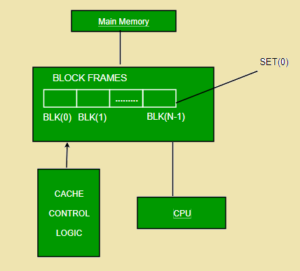
Associative mapping overcomes the disadvantage of direct mapping by permitting each main memory block to be loaded into any line of the cache. In this case, the cache control logic interprets a memory address simply as a Tag and a Word field. The Tag field uniquely identifies a block of main memory. To determine whether a block is in the cache, the cache control logic must simultaneously examine every line’s tag for a match.
3. Set-associative Mapping:
This form of mapping is an enhanced form of direct mapping where the drawbacks of direct mapping are removed. Set associative addresses the problem of possible thrashing in the direct mapping method. It does this by saying that instead of having exactly one line that a block can map to in the cache, we will group a few lines together creating a set. Then a block in memory can map to any one of the lines of a specific set..Set-associative mapping allows that each word that is present in the cache can have two or more words in the main memory for the same index address. Set associative cache mapping combines the best of direct and associative cache mapping techniques.
In this case, the cache consists of a number of sets, each of which consists of a number of lines. The relationships are
m = v * k
i= j mod v
where
i=cache set number
j=main memory block number
v=number of sets
m=number of lines in the cache number of sets
k=number of lines in each set.
Set-associative mapping is a compromise that exhibits the strengths of both the direct and associative approaches while reducing their disadvantages. In this case, the cache consists of a number sets, each of which consists of a number of lines. The relationships are Where, i =cache set number j= main memory block number m= number of lines in the cache number of sets k= number of lines in each set.


Application of Cache Memory:
- Usually, the cache memory can store a reasonable number of blocks at any given time, but this number is small compared to the total number of blocks in the main memory.
- The correspondence between the main memory blocks and those in the cache is specified by a mapping function.
Types of Cache –
- Primary Cache –
A primary cache is always located on the processor chip. This cache is small and its access time is comparable to that of processor registers. - Secondary Cache –
Secondary cache is placed between the primary cache and the rest of the memory. It is referred to as the level 2 (L2) cache. Often, the Level 2 cache is also housed on the processor chip.
Locality of reference:
Since size of cache memory is less as compared to main memory. So to check which part of main memory should be given priority and loaded in cache is decided based on locality of reference.
Types of Locality of reference
- Spatial Locality of reference
This says that there is a chance that element will be present in the close proximity to the reference point and next time if again searched then more close proximity to the point of reference. - Temporal Locality of reference
In this Least recently used algorithm will be used. Whenever there is page fault occurs within a word will not only load word in main memory but complete page fault will be loaded because spatial locality of reference rule says that if you are referring any word next word will be referred in its register that’s why we load complete page table so the complete block will be loaded.

0 Comments